The issues surrounding Avery Fisher Hall, home of the New York Philharmonic, could make up a novel. Concert halls such as the Boston Symphony Hall (completed 1900), the Vienna Musikvereinssall (1870), and the Leipzig Gewandhaus (1885) are famous for their impeccable acoustics. The Avery Fisher Hall, completed in 1962, is not. The hall has gone through major renovations to improve its infamously problematic acoustic quality.
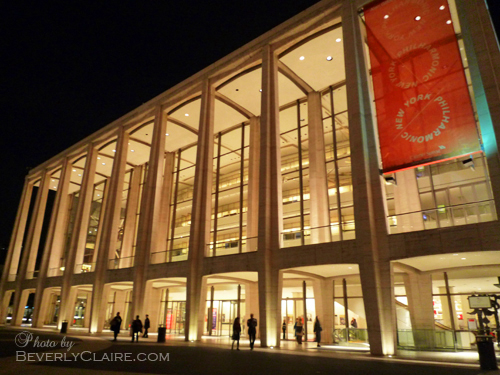
The Avery Fisher Hall at night.
When we went there October of 2011, the hall had just undergone its latest renovation the year before. The New York Times describes the trials and tribulations of the concert hall as it tries to improve what had become something of a bad example in the (dark?) art and science of acoustic design.
Bravo, New York Phil
Acoustics aside, my husband wanted to see in particular Lorin Maazel—former child prodigy and known for his technical mastery—conduct the New York Phil. The night’s program consisted of Mozart’s Symphony No. 38 in D major, Prague (1768) and Concerto in C major for Flute & Harp (1778), featuring Robert Langevin on the flute and Nancy Allen on the harp. We read the playbill for some interesting notes. It seemed that Mozart felt under-appreciated in the music capital of Vienna, but at Prague he was showered with undiluted adulation. The symphony was his gift to the city. The concerto for flute and violin was a commission from the flute-playing aristocrat Duc de Guines (1735-1806), who had a musically gifted, harp virtuoso of a daughter that Mozart tutored in composition.
We quite enjoyed both performances. Maazel is over 80 years of age but you wouldn’t know it unless you did some arithmetic. He was music director of the New York Phil for seven years (2002-2009) and obviously he knew them well and they him. My husband summed up their performance of Symphony No. 38 as “business as usual”. As for me, I liked the cheerful flute and harp concerto, elegantly played by Allen, a prominent harpist and New York native. The Canadian flutist Langevin was expressive; I felt that he truly enjoyed playing this particular piece.

Views of the concert hall interior at the Avery Fisher Hall.
All right, now that I’ve commented on the music, let’s move on back to the concert hall itself. No, wait. After the intermission the next performance were two works by Debussy, Juex: Poeme danse (1912-13) and Iberia, from Images for Orchestra (1905-08). I know that Debussy fans will pelt me with rotten vegetables when I say this, but the only Debussy works I could honestly say I enjoy and would not mind listening to again and again are Prelude to the Afternoon of a Faun and Clair de Lune. For the rest of his works I struggle with all the turbulent, impressionist, symbolist complexity. So it was for my husband—who enjoys Debussy and the other transitional composers of that era (and beyond)—that I sat there and grit my teeth.
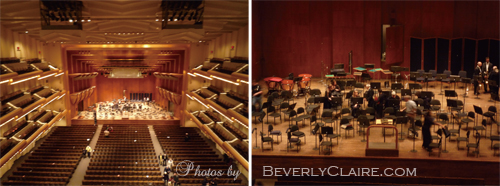
End of tonight's concert at the Avery Fisher Hall.
Of course, this is all about personal taste (or the lack thereof, as the case may be). The New York Phil was their polished, brilliant self.
The Concert Hall Acoustics Issue
So going back to the acoustics issue. It is said that Fisher Hall was originally planned to have a seating capacity of 2,400, but a change came late in the planning process, expanding the hall to hold 2,700 and effectively ruining the acoustical quality.
I have not been to the legendary concert halls of Europe (or Boston) so I cannot say how bad Fisher Hall’s sounded compared to the great halls. The halls I frequent are the ones in and around the city of Tokyo. There’s the NHK Hall (1972), a relative behemoth with a seating capacity of about 3,600. I only go there because it’s home to the NHK Symphony Orchestra, and whether I sit in front or on the balcony I always feel that the place is way too big for a symphony orchestra. But while the acoustic quality is not terrible, the lounge area’s ceiling is low, the upholstery is shabby; the place could do well with an interior facelift.

Across the Fisher Hall is the David Koch Theater.
The opposite of NHK Hall is the relatively new, shiny Tokyo Opera City Concert Hall (1997). It’s all modern, with plenty of natural wood paneling and a seating capacity of about 1,600. Here the Tokyo City Philharmonic Orchestra plays its subscription concerts. At one time I sat in front about five rows away from the orchestra; the sound was so loud my ears hurt and they were still ringing an hour or so after the performance. This place is way too small for a full symphony orchestra! The next time I was there I made sure I stayed away from the stage and chose an upper tier seat; this time the sound was rather scrappy. Was it the overly high, non-conventional, pyramid-shaped ceiling? I don’t know but this time my ears didn’t like it either.
Then there’s the Tokyo Bunka Kaikan (1961), with a 2,300 seating capacity distributed over five tiers. This is where the Tokyo Metropolitan Symphony Orchestra performs, but it’s also a multipurpose hall that hosts the ballet and other musical performances. I watched Daniel Barenboim do a solo piano recital here and it sounded magnificent. The Tokyo Met sounded good, too. I have zero acoustic complaints for this hall; the only complaint I have is that the place is even shabbier than the NHK Hall.
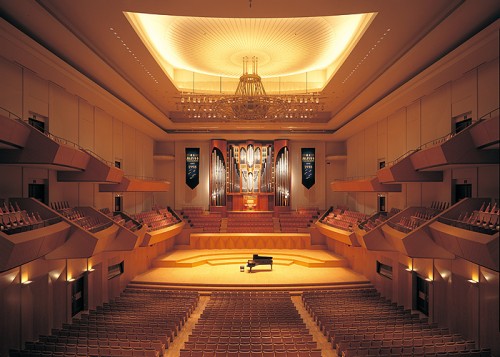
The Yokohama Minato Miral Hall. Photo courtesy of yaf.or.jp
My favorite concert hall in Japan is one that’s in the city where I live, the Yokohama Minato Mirai Hall (1998). With a seating capacity of about 2,000, this concert hall feels “just right”. It’s a beauty, too, in and out. While I don’t think any concert hall here in Japan can beat Tokyo Opera City in terms of surrounding facilities (spectacular night views, restaurants, shops, accessibility), the Minato Mirai Hall has a bit of mellow warmth to it. It is shoe-box shaped with seats surrounding the stage. In this hall the sound and views are intimate but not confining.
It Wasn’t Bad at All
So, going back to the Avery Fisher Hall, how did it sound? Good, I’d say. We took an upper level seat above right of the orchestra. I could watch the musicians play while getting a good view of the entire hall. My ears had no complaints regarding acoustics. I asked my husband how the hall sounded to him. “It was okay”, he said, “but not nearly as good as The Met.” He was talking, of course, of The Metropolitan Opera, performing in their own hall within the Lincoln Center complex. The Met is another story altogether, so we’ll get to it in another article.
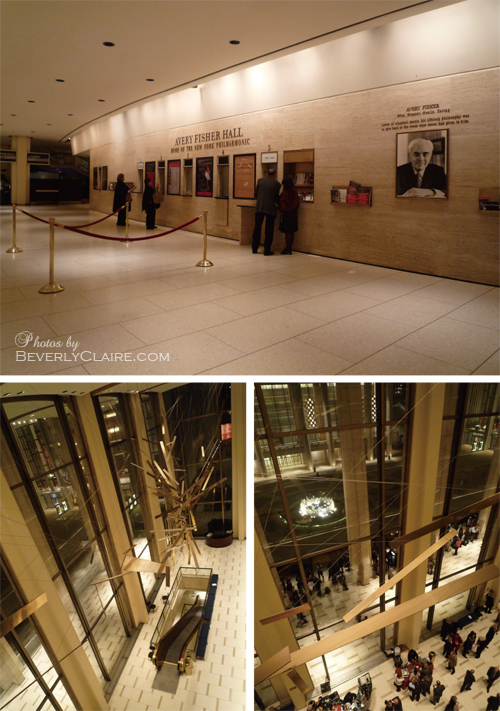
Views of the lobby at the Avery Fisher Hall.
Whatever the issues with the acoustics, Fisher Hall looked good everywhere else: the modern facade with its expansive glass walls, the lobby’s marble-paneled walls and stone floors, a contemporary sculptural installation decorating the foyer’s ceiling, and a large black-and-white portrait of Avery Fisher, the philanthropist for whom the hall was named.
It’s Complicated
Needless to say, acoustic design is an incredibly complicated matter. It involves everything from the shape and location of the hall, the adjustable/movable parts of the auditorium, type of materials, seating capacity, fire and building codes, where you sit, and yes, the size of the orchestra and the kind of music performed. Minus the differences in personal taste and holding constant the skill of the musicians and conductor, it’s not surprising to listen to the same orchestra in the exact same hall and think they sounded better playing, say, a romantic Brahms piece than an expressionist Schoenberg.
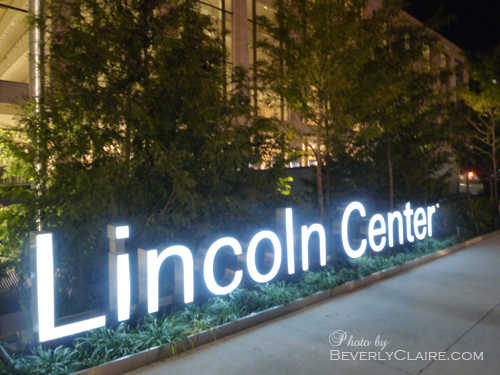
Front of the Lincoln Center at night.
You hear of concert halls so scientifically “advanced” that they appear cold and clinical. Then there are the legendary concert halls in Europe built long before the science of acoustics has been written about in books, but everyone who’s ever sat there says it was like listening to angels sing. For those of us that are not hanging out in Vienna or Boston most of the time, we make do with what is in our neighborhood. These halls might not be classified as great, but they are good enough for us.
What About You?
What’s your favorite concert hall and why? I’d love to hear your thoughts in the comments section!
External Links
The New York Philharmonic – official site
Lorin Maazel – official site
Lincoln Center for the Performing Arts – official site
Yokohama Minato Mirai Hall – official site
Music to Consider

























 Welcome! Whenever I plan an itinerary I try to read the first-hand account of others. Why? Because it helps! This site contains not just detailed accounts of my experiences, but also things I learned along the way. Hopefully they'll be a source of information (and inspiration?) to you. Enjoy!
Welcome! Whenever I plan an itinerary I try to read the first-hand account of others. Why? Because it helps! This site contains not just detailed accounts of my experiences, but also things I learned along the way. Hopefully they'll be a source of information (and inspiration?) to you. Enjoy!
For someone like you who listens ONLY to Baroque music 24/7, sitting through a Debussy was really stretching yourself, I’d say. 😉
Hi Hana! For someone like you who listens almost exclusively to the Romantic composers… 😉
I do have 1.FM’s All Baroque Music playing now, as per usual.
hey! i cant believe you didnt mention 愛知芸術文化センターコンサートホール aichi arts center concert hall. you used to go there a lot! didnt you like the acoustics? whats this tokyo-only thing now???
Hey there Krissie! Ahh, yes, the Aichi Arts Center Concert Hall was indeed one of my favorite places in Nagoya. Thank you for reminding me! 🙂 I hadn’t gone there for such a long time now so I thought I’d omit it. If I included it I would have to add those I went to in Osaka, Saitama, etc many years ago and it would make a long list!
BTW, what is YOUR favorite concert hall?
without doubt, boston! haven’t been to any of the famed european concert halls, though.
The only concert hall I know of is the CCP’s Nicanor Abelardo Theatre. According to Wikipilipinas: “The theater has four levels: Orchestra, Boxes, Balcony I, and Balcony II, that can accommodate a total of 1,823 guests.” Small, eh? Sitting on balcony II gives one a vertiginous feeling. I think its acoustics are all right but I can’t compare it with anything else as all the other concert halls I’ve been in are much smaller.
Thanks for sharing! I don’t think 1,800 is small. 🙂 I would like to watch a performance there someday.
Some comments on the article from Google Plus.
http://bit.ly/u8bbiR
Mim wrote:
“Interesting article with lovely photos. But I’m surprised you did not mention New York’s Carnegie Hall or even the Concertgebouw in Amsterdam when comparing acoustics of concert venues. To me, those are the best, with warm, rich, sonorous acoustics, though I’ve not been to the others you mention and though, as you say, the perception often depends on the piece, the size of the audience and other factors.”